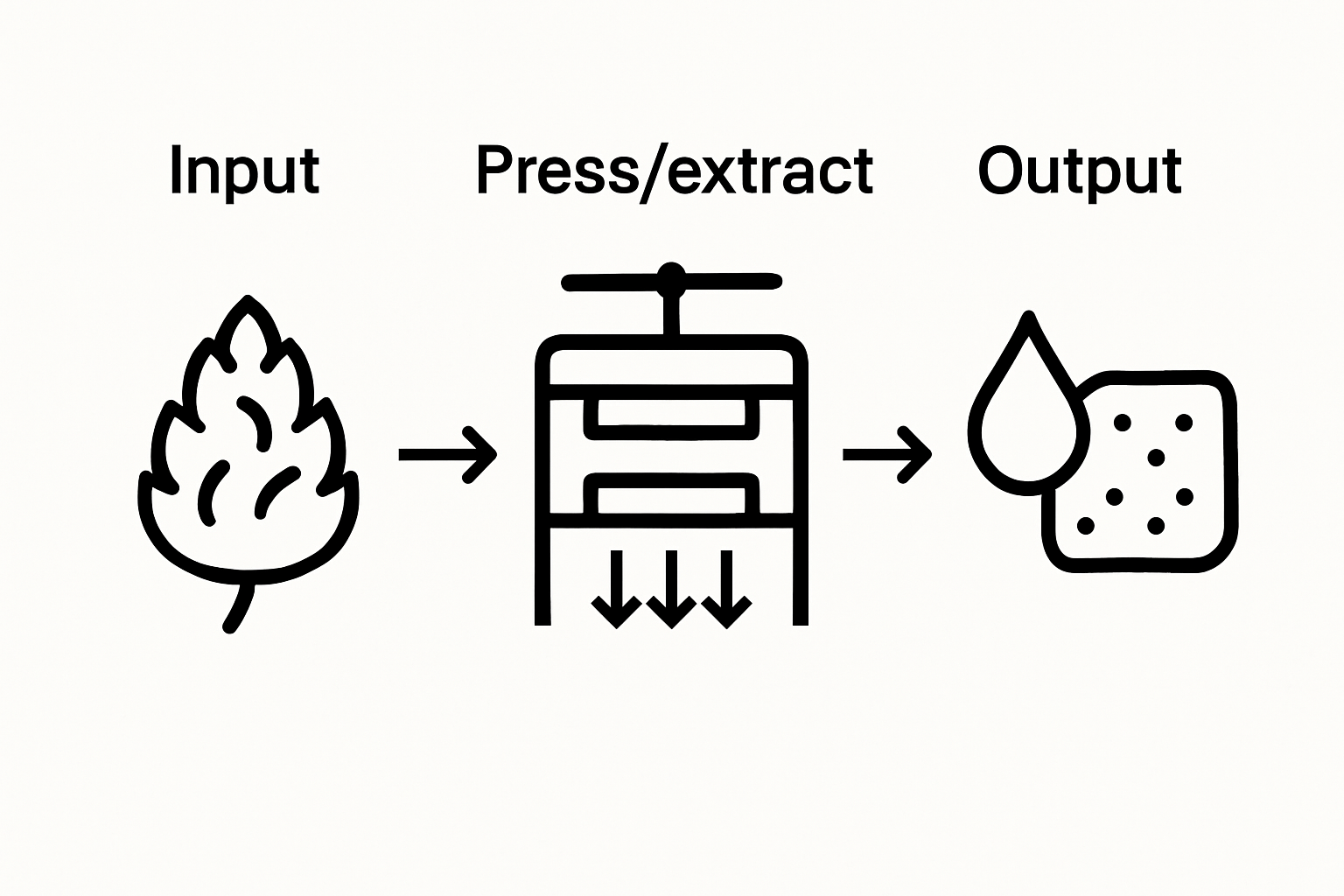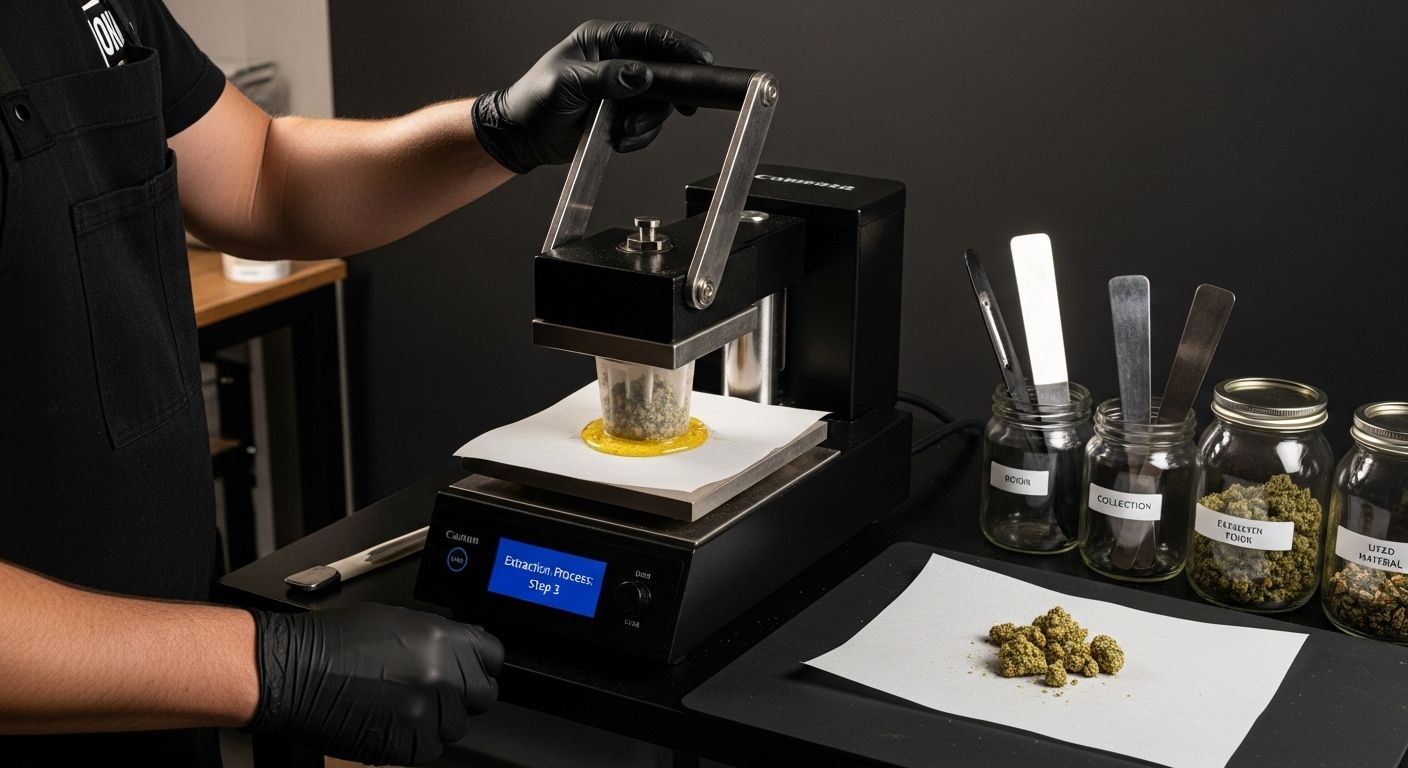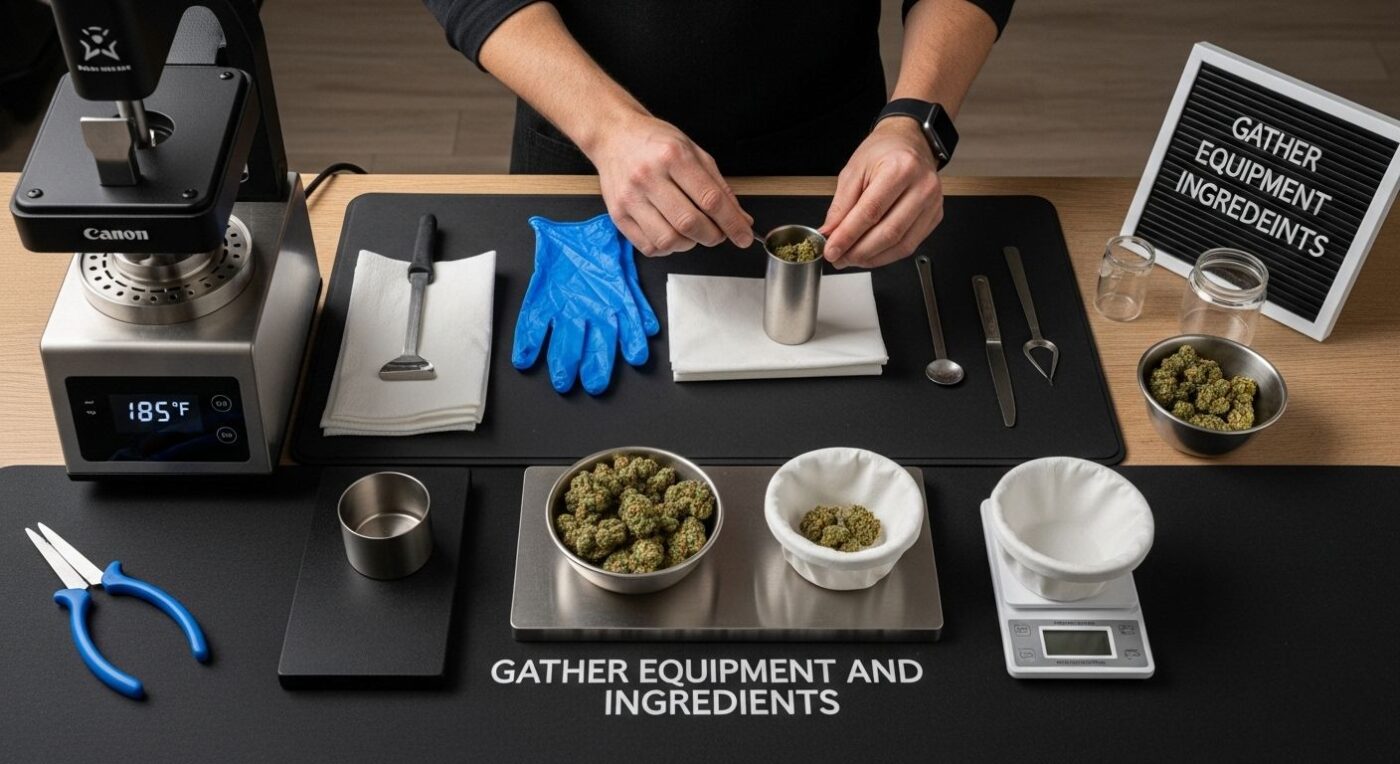Blog
Guide to Solventless Extraction: Craft Quality Edibles
Making premium edibles at home might sound tricky, but the secret often lies in the preparation before you even start cooking. Most people focus on recipes, but the biggest difference actually comes from the extraction process. A professional rosin press can apply controlled heat and pressure between 160 and 220 degrees Fahrenheit, directly shaping flavor and potency. Think ordinary kitchen gear can compare? This preparation step is where quality edibles truly begin.
Table of Contents
- Step 1: Gather Necessary Equipment And Ingredients
- Step 2: Prepare Your Cannabis Material For Extraction
- Step 3: Execute The Extraction Process Using Heat And Pressure
- Step 4: Collect And Purify The Extracted Cannabis Oil
- Step 5: Verify Quality Through Testing And Consistency Check
Quick Summary
| Key Point | Explanation |
|---|---|
| 1. Gather high-quality equipment | Use a rosin press with digital controls for precise heat management. This is crucial for a successful extraction process. |
| 2. Select premium Cannabis material | Choose well-cured, dense Cannabis flowers with rich trichomes for maximum potency and oil quality. Quality impacts the end product substantially. |
| 3. Maintain a clean workspace | Keep your environment sterilized and temperature-controlled to avoid contamination during extraction. This ensures purity and quality of your rosin. |
| 4. Follow precise extraction techniques | Apply gradual, controlled pressure and temperature during extraction. This influences the consistency, color, and flavor of the final product. |
| 5. Test and verify quality | Use digital testing tools to measure potency and moisture content. Consistent quality checks ensure a reliable and safe final product. |
Step 1: Gather Necessary Equipment and Ingredients
Starting your solventless extraction journey requires careful preparation and selecting the right tools. This foundational step determines the quality and success of your final product, so gathering the proper equipment and ingredients is crucial for creating premium edibles.
Begin by assembling your core extraction toolkit. Essential equipment includes rosin press machines, which can range from professional hydraulic presses to compact home models. You’ll want a press capable of applying consistent, controlled pressure between heated plates. Professional extractors recommend models with digital temperature controls, allowing precise heat management between 160 and 220 degrees Fahrenheit.
For ingredient selection, prioritize high-quality starting materials. Premium hash requires top-grade plant material – seek out fresh, well-cured Cannabis flower or carefully processed bubble hash. The quality of your source material directly impacts extraction efficiency and final product potency. Look for Cannabis strains with robust trichome development and minimal plant contaminants.
Your ingredient list should also include:
- Micron-specific filter bags for mechanical separation
- High-quality parchment paper for collection
- Heat-resistance gloves for safety
- Digital scale for precise measurements
Additionally, create a clean, temperature-controlled workspace. Maintain an environment around 65-70 degrees Fahrenheit with minimal humidity. Cleanliness is paramount – sanitize all equipment beforehand and work on a sterile surface to prevent contamination.
According to research from the National Center for Biotechnology Information, proper preparation significantly impacts extraction quality. Professional extractors recommend running small test batches to calibrate your technique before attempting larger productions.
By meticulously gathering equipment and understanding your ingredients, you’re setting the stage for a successful solventless extraction process.
Below is a checklist table summarizing essential equipment and ingredient requirements for solventless extraction, making it easy to ensure you have everything needed for a quality extraction session.
| Equipment/Ingredient | Purpose | Specifications/Notes |
|---|---|---|
| Rosin Press Machine | Apply heat and pressure | Digital temperature control, 160-220°F |
| Micron Filter Bags | Separate trichomes from plant matter | Multiple sizes for precise filtration |
| Parchment Paper | Collect extracted rosin | Food-grade, high quality |
| Heat-Resistant Gloves | Safety during extraction | Insulated, durable |
| Digital Scale | Accurate measurement | 0.01g precision recommended |
| Clean Workspace | Prevent contamination | 65-70°F, minimal humidity, sanitized |
| High-Quality Cannabis | Source material for extraction | Well-cured, dense, trichome-rich flowers |
Step 2: Prepare Your Cannabis Material for Extraction
Preparing your Cannabis material represents a critical phase in the solventless extraction process that directly impacts the quality and potency of your final product. This step transforms raw plant material into a refined, extraction-ready substance through careful handling and precision techniques.
Proper material selection begins with choosing high-quality, well-cured Cannabis flower. Look for dense, trichome-rich buds with minimal moisture content. Your goal is identifying plant material with maximum resin production and minimal contaminants. Professional extractors recommend selecting strains known for their robust terpene profiles and dense trichome coverage.
Careful trimming becomes your next essential task. Using sharp, clean scissors, meticulously remove larger fan leaf structures and stem materials. Focus on preserving delicate trichome heads during this process. Work in a cool, controlled environment to prevent trichome degradation. Gentle handling minimizes potential resin gland damage and maintains the intricate chemical composition of your starting material.
After trimming, you’ll want to prepare your Cannabis for mechanical separation. Sifting and grading become crucial techniques for creating consistent, high-quality hash. Use multiple micron-specific screens to separate trichome heads from plant material. Professional extractors typically recommend working with screens ranging between 25 and 160 microns, allowing precise trichome collection based on size and quality.
Your preparation checklist should include:
- Sanitized work surface
- Sharp, clean trimming scissors
- Multiple micron-grade screens
- Cool, dark workspace
- Humidity-controlled environment
According to Health Canada’s guidelines for Cannabis production, maintaining strict cleanliness and minimizing contamination are paramount during material preparation. This means working in a sterile environment, using clean tools, and preventing unnecessary physical contact with your source material.
Successful preparation is characterized by uniform trichome separation, minimal plant material contamination, and preservation of delicate resin glands. Your meticulously prepared Cannabis is now primed for the next stage of solventless extraction, setting the foundation for exceptional hash rosin production.
Step 3: Execute the Extraction Process Using Heat and Pressure
The extraction process represents the transformative moment where carefully prepared Cannabis material becomes concentrated hash rosin. Precise heat and pressure application determines the quality, potency, and purity of your final product, making this step both an art and a scientific procedure.
Begin by calibrating your rosin press. Temperature management is critical, with ideal ranges typically between 180 and 220 degrees Fahrenheit. Lower temperatures around 180 degrees preserve more delicate terpenes, while higher temperatures near 220 degrees extract more cannabinoids. Your specific strain and desired outcome will guide your temperature selection.
Prepare your material by placing it inside high-quality micron filter bags. Silk screen or rosin bags work best, with 90 to 120 micron sizes recommended for optimal trichome separation. Position the bag carefully in the center of your press’s heated plates, ensuring even pressure distribution. Professional extractors suggest using parchment paper to collect the extracted rosin, preventing direct contact and potential contamination.
Your extraction technique requires methodical pressure application. Start with gentle, consistent pressure, gradually increasing to prevent immediate blowout or material rupture. Most experienced extractors recommend a two-stage pressing technique:
- Initial light pressure for 30 seconds to warm material
- Gradual increase to full pressing pressure
- Total press time between 45 to 90 seconds
Watch for visual indicators of successful extraction. Quality rosin appears as a golden, translucent liquid, flowing smoothly across the parchment paper. The consistency should resemble honey or light amber oil. Avoid overheating, which can degrade cannabinoids and terpenes, resulting in a darker, less flavorful extract.
According to research exploring extraction techniques, pressure variations significantly impact extraction yield and quality. Maintaining consistent, controlled pressure ensures maximum resin extraction while preserving the delicate chemical profile of your Cannabis material.
Successful extraction is characterized by a clean, translucent rosin with minimal plant material contamination.
 The final product should demonstrate rich color, smooth texture, and a robust aromatic profile reflecting your original Cannabis strain.
The final product should demonstrate rich color, smooth texture, and a robust aromatic profile reflecting your original Cannabis strain.

Step 4: Collect and Purify the Extracted Cannabis Oil
Collecting and purifying your extracted Cannabis oil transforms raw rosin into a refined, high-quality concentrate ready for edible production. This critical step determines the final product’s potency, flavor, and overall quality, requiring precision and careful technique.
Begin by carefully removing your extracted rosin from the parchment paper. Use a clean, non-stick collection tool like a specialized rosin collection tool or a sanitized metal dabber. Work in a temperature-controlled environment, ideally between 65 and 70 degrees Fahrenheit, to maintain the oil’s delicate molecular structure. Gentle manipulation prevents terpene degradation and preserves the extract’s complex chemical profile.
Purification involves removing residual plant materials and ensuring a clean, consistent concentrate. Utilize low-heat techniques for further refinement, such as gentle warming to improve oil malleability. Professional extractors recommend using a secondary heating surface set between 90 and 110 degrees Fahrenheit. This process helps eliminate any remaining moisture and creates a more homogeneous extract without compromising cannabinoid integrity.
Your purification toolkit should include:
- Precision collection tools
- Low-temperature heating surface
- Clean, non-stick containers
- Digital thermometer
- Gloves for sterile handling
Careful observation is key during this stage. High-quality rosin demonstrates specific visual characteristics. Look for a translucent, golden to amber-colored oil with a honey-like consistency. The extract should spread smoothly without visible plant contamination or dark particulate matter. Avoid aggressive manipulation that could introduce additional impurities or break down delicate cannabinoid structures.
According to research exploring cannabinoid extraction techniques, decarboxylation plays a crucial role in activating cannabinoids. While full decarboxylation occurs during edible preparation, gentle warming during collection helps initiate this transformation, potentially enhancing the oil’s bioavailability.
Successful collection and purification results in a clean, aromatic concentrate with rich color, smooth texture, and preserved terpene profile. Your meticulously processed rosin is now prepared for the final stage of edible creation, representing the pinnacle of solventless extraction craftsmanship.
Step 5: Verify Quality Through Testing and Consistency Check
Quality verification represents the critical final stage of solventless extraction, transforming your carefully crafted concentrate into a reliable, safe product. This step ensures your extracted Cannabis oil meets professional standards of potency, purity, and consistency through systematic evaluation and precise measurement techniques.
Visual and sensory inspection forms the first layer of quality assessment. Examine your extracted rosin under natural light, looking for specific characteristics that indicate superior quality. A premium extract displays a translucent, golden to amber color with a smooth, honey-like consistency. Professional extractors recommend checking for clarity, absence of plant material, and uniform texture. Any dark specks, cloudiness, or uneven coloration signals potential contamination or improper extraction.
Quantitative testing requires specialized equipment to measure cannabinoid profiles and potential contaminants. Utilize digital tools like precision scales and laboratory-grade testing kits to analyze your extract’s composition. Measure total cannabinoid concentration, focusing on THC and CBD percentages. Check for residual moisture content, ensuring it remains below 5% to prevent potential degradation or mold development.
Your quality verification checklist should include:
- Digital precision scale
- Cannabinoid testing strips
- Moisture content meter
- Magnifying lens or microscope
- Clean, sterile sampling containers
Consistency verification involves comparing multiple extraction batches. Create controlled documentation tracking each extraction’s specific parameters. Record temperature settings, pressure levels, starting material characteristics, and resulting extract qualities. This systematic approach allows you to replicate successful extractions and identify potential variables affecting your final product.
According to the National Institute of Standards and Technology, standardized testing methods are crucial for ensuring product safety and reliability. By implementing rigorous quality checks, you transform your solventless extraction from an artisan process to a scientifically validated procedure.
Successful quality verification is characterized by a clean, potent extract that meets predetermined standards.
This quick reference table outlines the five main steps in solventless extraction, summarizing the goal and result of each phase to help users follow the process more effectively.
| Step | Primary Goal | Key Outcome |
|---|---|---|
| Gather Equipment & Ingredients | Assemble all necessary tools and materials | Ready workspace and premium inputs |
| Prepare Cannabis Material | Optimize plant matter for extraction | Clean, trichome-rich starting material |
| Execute Extraction (Heat & Pressure) | Extract resin using precise controls | Hash rosin collected on parchment |
| Collect & Purify Extracted Oil | Refine and clean the concentrate | Homogenous, high-purity extract |
| Verify Quality (Testing & Consistency) | Ensure potency, purity, and consistency | Tested, reliable cannabis oil |
Bring Out the Best in Solventless Edibles—Without the Guesswork
Have you spent hours gathering equipment and perfecting your solventless extraction process, only to worry about the purity and consistency of your final edibles? Many passionate creators struggle with ensuring their edibles are truly solvent-free, potent, and bursting with real flavor. The step-by-step guide you just explored highlights challenges such as sourcing clean ingredients, applying the right pressure and temperature, and verifying extract quality. At Good Tide CBD Gummies, we give you the results you want—without the uncertainty. Our gummies are made with authentic solventless hash rosin, crafted in trusted facilities, and each batch is tested for potency, purity, and cannabinoid profile.

Why settle for untested, homemade edibles or questionable quality when you can experience the real thing? Discover the genuine taste and true benefits of expertly crafted solventless gummies with Good Tide CBD Gummies. See how we put transparency into action by exploring our product catalog, ingredient lists, and verified lab results. Start your journey toward pure, flavorful relaxation by visiting our homepage right now. Taste the difference and enjoy peace of mind with every bite.
Frequently Asked Questions
What equipment is necessary for solventless extraction?
To perform solventless extraction, you’ll need essential equipment such as a rosin press machine, micron-specific filter bags, parchment paper, heat-resistant gloves, and a digital scale. A clean, temperature-controlled workspace is also crucial for successful extraction.
How do I prepare Cannabis material for extraction?
Begin by selecting high-quality, well-cured Cannabis flower with dense trichomes. Trim away larger fan leaves and stems carefully, and use multiple micron-specific screens for sifting and grading to achieve consistent trichome separation.
What is the optimal temperature and pressure for extracting rosin?
The ideal temperature for extracting rosin typically ranges from 180 to 220 degrees Fahrenheit. Beginners should start at lower temperatures to preserve terpenes while increasing pressure gradually during the extraction process over a duration of 45 to 90 seconds.
How can I verify the quality of my extracted Cannabis oil?
Quality verification involves both visual inspection and quantitative testing. Check for a clear, golden to amber color, smooth consistency, and absence of plant material. Use precision tools to measure cannabinoid content and moisture levels to ensure your extract meets safety and potency standards.

